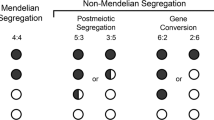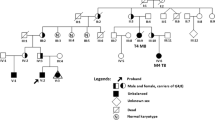Summary
Although clear genetic evidence of mitotic crossing-over is lacking in man, observations of mitotic chiasmata in normal cells (0.1–1 per 1000) and in Bloom's syndrome (BS) cells (5–150 per 1000) demonstrate its occurrence. That mitotic chiasmata are true exchanges is concluded from the occurrence of heteromorphic “bivalents” and the pattern of sister chromatid exchanges in mitotic “bivalents”. Several observations demonstrate that chiasmata are different in principle from chromatid translocations which simply happen to take place at homologous loci. For example, the ratio of adjacent exchanges to mitotic chiasmata is 1/20–1/60, whereas this ratio is approximately 1:1 for chromatid translocations. Furthermore, mitotic chiasmata make up a very high proportion of total quadriradials (QRs): 48% in normal untreated cells and 90% in BS cells.
Close proximity of homologous chromosomes promotes mitotic crossing-over. Thus in normal diplochromosomes, the incidence is increased a hundred-fold as compared to diploid cells. However, closeness of homologues is not the only factor promoting crossing-over; the BS gene specifically promotes exchanges between homologous segments as shown by the roughly 15-fold increase of chiasmata in BS diplochromosomes as compared to normal diplochromosomes.
Mitotic chiasmata are distributed extremely nonrandomly in different chromosomes and chromosome segments. The preferred sites are short Q-dark regions, 3p21, 6p21, 11q13, 12q13, 17q12, and 19p13 or q13 being veritable hot spots. Our preferred hypothesis is that the hot spots have higher gene densities than other regions. Consequently they are active and extended in interphase which would promote their pairing and chiasma formation.
Segregation after mitotic corssing-over in satellite stalks can be demonstrated by means of distinct satellites. In a BS patient there were 31 different patterns for Q-bright satellites in 58 cells. Segregation after presumed crossing-over has also been seen in three dicentric chromosomes with one centromere inactivated. Recombination in satellite stalks in BS resulted in 12/58 cells homozygous for Q-bright satellites. In two of these cells, two chromosomes were homozygous for Q-bright satellites, and in one cell, three chromosomes were homozygous. This high degree of homozygosity which obviously applies to other chromosome regions too, may explain the high incidence of malignant disease in BS on the assumption that cancer is caused by recessive genes.
Similar content being viewed by others
References
Arnheim N, Krystal M, Schmickel R, Wilson G, Ryder O, Zimmer E (1980) Molecular evidence for genetic exchanges among ribosomal genes on nonhomologous chromosomes in man and apes. Proc Natl Acad Sci USA 77:7323–7327
Avivi L, Feldman M (1980) Arrangement of chromosomes in the interphase nucleus of plants. Hum Genet 55:281–295
Bartram CR, Koske-Westphal T, Passarge E (1976) Chromatid exchanges in ataxia telangiectasia, Bloom syndrome, Werner syndrome, and xeroderma pigmentosum. Ann Hum Genet 40:79–86
Chaganti RSK, Schonberg S, German J (1974) A manyfold increase in sister chromatid exchanges in bloom's syndrome lymphocytes. Proc Natl Acad Sci USA 71:4508–4512
Comings DE (1980) Arrangement of chromatin in the nucleus. Hum Genet 53:131–143
Craig-Holmes AP, Moore FB, Shaw MW (1975) Polymorphism of human C-band heterochromatin. II. Family studies with suggestive evidence for somatic crossing over. Am J Hum Genet 27:178–189
Darlington CD (1932) Recent advances in cytology. Blakiston's Son and Co, Philadelphia
Egozcue J (1968) Spontaneous chromosomal exchanges in primates. Genetics 60:771–779
Festa RS, Meadows AT, Boshes RA (1979) Leukemia in a black child with Bloom's syndrome. Cancer 44:1507–1510
German J (1964) Cytological evidence for crossing-over in vitro in human lymphoid cells. Science 144:298–301
German J (1972) Genes which increase chromosomal instability in somatic cells and predispose to cancer. Prog Med Genet 8:61–101
German J (1979) Bloom's syndrome. VIII. Review of clinical and genetic aspects. In: Goodman RM, Motulsky AG (eds) Genetic diseases among Ashkenasi jews. Raven Press, New York, pp 121–139
German J, Archibald R, Bloom D (1965) Chromosomal breakage in a rare and probably genetically determined syndrome of man. Science 148:506–507
German J, Crippa LP, Bloom D (1974) Bloom's syndrome. III. Analysis of the chromosome aberration characteristic of this disorder. Chromosoma 48:361–366
Grüneberg H (1966) The case for somatic crossing over in the mouse. Genet Res 7:58–75
Huttner KM, Ruddle FH (1976) Study of mitomycin C-induced chromosomal exchange. Chromosoma 56:1–13
Jones GH (1969) Further correlations between chiasmata and U-type exchanges in rye meiosis. Chromosoma 26:105–118
Korenberg JR, Therman E, Denniston C (1978) Hot spots and functional organization of human chromosomes. Hum Genet 43:13–22
Kuhn EM (1974) Nonrandom localization of mitotic crossing-over in Bloom's syndrome. Genetics 77:Suppl 37–38
Kuhn EM (1976) Localization by Q-banding of mitotic chiasmata in cases of Bloom's syndrome. Chromosoma 57:1–11
Kuhn EM (1978) Mitotic chiasmata and other quadriradials in mitomycin C-treated Bloom's syndrome lymphocytes. Chromosoma 66: 287–297
Kuhn EM (1980) Effects of X-irradiation in G1 and G2 on Bloom's syndrome and normal chromosomes. Hum Genet 54:335–341
Kuhn EM (to be published) A high incidence of mitotic chiasmata in endoreduplicated Bloom's syndrome cells. Hum Genet
Kuhn EM, Therman E (1979a) Chromosome breakage and rejoining of sister chromatids in Bloom's syndrome. Chromosoma 73:275–286
Kuhn EM, Therman E (1979b) No increased chromosome breakage in three Bloom's syndrome heterozygotes. J Med Genet 16:219–222
Littlefield LG, Goh K-O (1973) Cytogenetic studies in control men and women. I. Variations in aberration frequencies in 29,709 metaphases from 305 cultures obtained over a three-year period. Cytogenet Cell Genet 12:17–34
Otto PG, Otto PA, Therman E (to be published) The behavior of allocyclic chromosomes in Bloom's syndrome. Chromosoma
Pallister PD, Patau K, Inhorn SL, Opitz JM (1974) A woman with multiple congenital anomalies, mental retardation and mosaicism for an unusual translocation chromosome t(6;19). Clin Genet 5: 188–195
Patau K (1963) The origin of chromosomal abnormalities. Pathol Biol (Paris) 11:1163–1170
Patau K, Therman E (1969) Mitotic crossing-over in man. Genetics 61: Suppl 45–46
Race RR, Sanger R (1975) Blood groups in man, 6th edn. Blackwell Scientific, Oxford London Edinburgh Melbourne
Radding CM (1978) Genetic recombination: Strand transfer and mismatch repair. Annu Rev Biochem 47:847–880
Sarto GE, Therman E (1980) Replication and inactivation of a dicentric X formed by telomeric fusion. Am J Obstet Gynecol 136:904–911
Schonberg S, Chaganti RSK, German J (1978) Terminal association of homologous chromosomes at metaphase, a new cytogenetic finding in Bloom's syndrome. J Cell Biol 79:132A
Schroeder TM, German J (1974) Bloom's syndrome and Fanconi's animia: Demonstration of two distinctive patterns of chromosome disruption and rearrangement. Hum Genet 25:299–306
Slightom JL, Blechl AE, Smithies O (1980) Human fetal 100-1 100-2 genes: Complete nucleotide sequences suggest that DNA can be exchanged between these duplicated genes. Cell 21:627–638
Smith GP (1976) Evolution of repeated DNA sequences by unequal crossover. Science 191:528–535
Smithies O (1964) Chromosomal rearrangements and protein structure. Cold Spring Harbor Symp Quant Biol 29:309–319
Szalay GC, Weinstein ED (1972) Questionable Bloom's syndrome in a negro girl. Am J Dis Child 124:245–248
Therman E (1980) Human chromosomes: Structure, behavior, effects. Springer, New York Heidelberg Berlin
Therman E, Kuhn EM (1976) Cytological demonstration of mitotic crossing-over in man. Cytogenet Cell Genet 17:254–267
Therman E, Denniston C, Sarto GE (1978) Mitotic chiasmata in human diplochromosomes. Hum Genet 45:131–135
Therman E, Otto PG, Shahidi NT (1981) Mitotic recombination and segregation of satellites in Bloom's syndrome. Chromosoma 82: 627–636
Therman E, Sarto GE, Patau K (1974) Apparently isodicentric but functionally monocentric X chromosome in man. Am J Hum Genet 26:83–92
Vogel F, Schroeder TM (1974) The internal order of the interphase nucleus. Hum Genet 25:265–297
Wozney J, Hanahan D, Morimoto R, Boedtker H, Doty P (1981) Fine structural analysis of the chicken pro α2 collagen gene. Proc Natl Acad Sci USA 78:712–716
Yamada Y, Avvedimento VE, Mudryj M, Ohkubo H, Vogeli G, Irani M, Pastan I, Crombrugghe B de (1980) The collagen gene: evidence for its evolutionary assembly by amplification of a DNA segment containing an exon of 54 bp. Cell 22:887–892
Zorn C, Cremer T, Cremer C, Zimmer J (1976) Laser UV micro-irradiation of interphase nuclei and post-treatment with caffeine. Hum Genet 35:83–89
Zorn C, Cremer C, Cremer T, Zimmer J (1979) Unscheduled DNA synthesis after partial UV irradiation of the cell nucleus. Exp Cell Res 124:111–119
Author information
Authors and Affiliations
Rights and permissions
About this article
Cite this article
Therman, E., Kuhn, E.M. Mitotic crossing-over and segregation in man. Hum Genet 59, 93–100 (1981). https://doi.org/10.1007/BF00293053
Received:
Issue Date:
DOI: https://doi.org/10.1007/BF00293053




